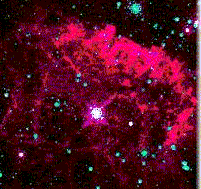 |
||
| First page | ||
 |
||
| Birth | ||
 |
||
| Main Sequence | ||
 |
||
| White Dwarf | ||
 |
||
| Red giant | ||
 |
||
| Supernova | ||
 |
Death | |
 |
||
 |
||
A star remains on the Main Sequence for most of its life and it changes very slowly there. The star gets its energy almost entirely from the thermonuclear reaction of hydrogen to helium. As you might know hydrogen is very common in our closest star, the Sun, which is a main sequence star.
The observed fact that most stars in the Galaxy lie along the main sequence is evidence that their chemical compositions are similar to the Sun. The stars that don't lie on the main sequence must differ somehow from the majority. There are three different possibilities for those stars; different chemical compostions (Red Giants), they are not stable (pre-main-sequence stars) or they are not shining by nuclear energy alone (pre-main-sequence stars and white dwarfs).

Stars in the lower end of the main sequence have a mass barely great enough to stop gravitational contraction. This critical mass is about one twelveth of the Suns mass. In the upper end the mass is about 100 times the Suns, and that is so great that radiation pressure dominates. The gravitational force isn't big enough causing the star to become unstable. When all hydrogen in the central part of a star has been used up, a core develops that contains only helium (and some heavier elements).
Since there is no longer anything to supply heat, the core begins to contract gravitationally, the star's structure changes and the star leaves the main sequence.
The lifetime of a star depends on two things; how much fuel it has and how fast it uses it up. We know that hydrogen is the main fuel source and that most of a stars mass consists of hydrogen. This means that the amount of fuel is proportional to the total mass of the star. The most massive stars have the shortest lifetimes. Because they have most fuel, they burn it so prodigously that their lifetimes are very short. A stars time on the main sequence varies from a few million to 2x1011. As we will see later, the way in which a star evolves depends on its mass.
23 August 2000
Sarah Amandusson
www_astro@mssl.ucl.ac.uk